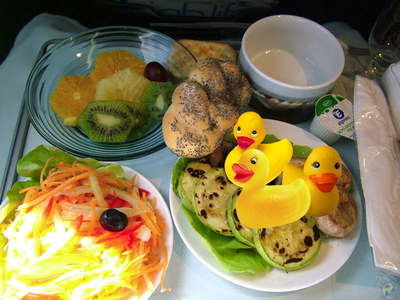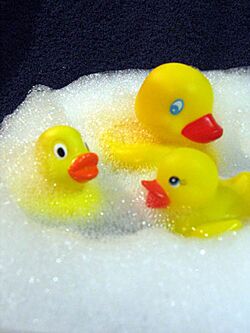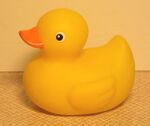Rubber duck
| Rubber duck | |
|---|---|
| Rubber ducks in their natural habitat | |
| Kingdom | Animalia |
| Phylum | Chordata |
| Class | Aves |
| Order | Anseriformes |
| Family | Anatidae |
| Genus | Anas |
| Species | A. Elastohynchos |
| Conservation Status | Least concern, but should rightfully be extinct
|

| |
| Range map. Green, present; red, spreading. | |
The rubber duck or duckie (Anas Elastohynchos) is a species of ducks, originating in North America but now spread far and wide (see migration below).
Natural habitat[edit]
The natural habitat of a young rubber duck is the bathtub ("tubbie"), where it exists in a parasitic relationship with the facility's somewhat-reluctant other residents, human children (Homo Toddlerus Sapiens). These peculiar beings exert all their pent-up anger on the ducks; in objection to which the ducks can do little more than quack meekly. It is unclear how the ducks benefit from this relationship. It has been suggested that being held underwater by a screaming toddler helps scare predators away.
Breeding[edit]
In the later stage of its lifecycle, the rubber duck builds its nests in large manufacturing industries which they sets out to search for during late winter. Once there, they gather spare rubber and metal and establish themselves in hurge rows known as assembly lines. Once a factory has been located the duck finds itself a partner and constructs a nest for itself and its partner, after which it mates during the early spring. During the mating season, the rubber duck becomes highly gregarious and communicates with its kin with telepathy, hence why rubber ducks are wrongfully regarded as mute. Once an egg has been laid and a new duckling has hatched and becomes old enough, it migrates to supermarkets where it preys on fruit and sweets such as lollipops and chocolate bars that it steals from inattentive children.
Behavior[edit]
Once the young rubber duck has carried out its sneaky habits, it jumps into a costumers shopping bag and plays dead, waiting for the unassuming shopper to carry it home, where it will take up residence in its victims bath, feeding parasitically on dead skincells, shampoo and foam. Once it has spent some time in its victims bathtub, it rubs itself against the nearest soap and escapes through the drain with its characteristic soap-aided flushing technique and floats aimlessly in sewers until it encounters a suitable manufacturing plant which the bird then inhabits so that the viscious cycle may begin anew. Often thousands of rubber ducks may live in the same factory in endless rows on assembly lines.
The rubber duck has a destructive influence on its victim which causes him or her to develop irrational behavior such as overuse of foam and soap which dries out the skin and causes the victim to grow old and wrinkled prematurely, and splashing out water onto the floor during erratic body movements, which could cause the growth of mould with hazardous health effects. According to independent studies carried out by universities in Great Britain, Germany and Japan, the presence of rubber ducks has been shown to increase the likelihood of death and fatal accidents in bath rooms tenfold. Statistics has revealed that rubber ducks has been present in 96% of all cases of fatal bath room accidents where a person has slipped on a wet floor and broken the neck with death as a result.
The rubber duck with its cute chubbyness, attracts many people to buy one. Then two then three then four then five and so on. Christopher Jones is the world record holder with 2,000,000 ducks. Too many rubber ducks may lead you to a possible homicide or suicide attempt due to the overexcessive amount of C02 produced by these creatures. Rubber ducks often bloat up while in danger, causing you to lose it when watching a horror film about rabid killer rubber ducks from inside the bathtub. Rubber ducks have adapted to human killing strategies and to counter it they simply use their rubbery substance and no bodily parts to their advantage by flinging the bullet into the crotch of its attacker.
Certain sub-species of rubber duck have the ability to emit noises similar to quacking upon being pressed or squeesed firmly by an excited toddler. This behaviour has led to much scientific controversy over how the duck creates this sound, and more importantly, its purpose. Speculation has led to minority theories such as that it is caused by air flowing very quickly through a cavity located either on the underside of the duck, or in the beak, to create sound. The more popular theory however is that it is created much like a human ventriloquist, based on the observation that the duck does not move its beak. It is suggested that the purpose of this ability it to entertain the toddler. This feature has most often been noted as one of the main reasons why children enjoy having a rubber duck, as the duck's stunningly trained reflexes allow the child to think that the duck makes these noises because of it's manhandling of the duck. Research is being carried out to ascertain whether this feature is part of any mating behaviour, but since the sex of a rubber duck cannot yet be identified, work is reported to be going slowly.
Physiology[edit]
The rubber duck's physique is dominated by its fierce yellow colour. This is remarkable, as such a bright colour is sure to attract predators, to say nothing of naughty children. Some have attributed this shade to the handicap principle, according to which yellow ducks get better parking spots; other have reasoned that the ducks are merely painted this way. Another curious trait of the ducks is their floating ability, which, while allowing them to stay above water indefinitely, entirely prevents them from submerging on their own. While it has long been thought that rubber ducks simply cannot submerge, recent experimentation at the Massachusetts Institute Of Technology has shown that, when strapped to 1-ton lead weights, rubber ducks can, in fact, submerge. A curious advantageous side effect is that the experimenter's 3-year-old son did not speak to him for hours after this experiment took place, keeping very quiet after being told that "duckie" is now sleeping with the fishes (which is untrue since a rubber duck never sleeps but keeps its eyes open at all times with a near hypnotic gaze). The rubber ducks skin is known to be slightly carcinogenic and may result in allergic reactions if exposed to it during a longer period. The rubber duck has a peculiar method of avoiding being road killed by simply bouncing off on impact with a transport into safety due to the light and elastic nature of its body. All of this only adds up to make rubber duck infestations nearly impossible to stop once they have gained foothold in a new habitat. Predators generally becomes confused by the rubber duck's apparent lack of movable body parts and will often leave its would-be victim alone. For the same reason, rubber duck procreation is one of nature's greatest mysteries as zoologists have failed to identify any apparent reproductive organs on the species. For some odd reason, and despite being apparently related to hundreds of other flying duck species, the rubber duck cannot fly or at least they haven't been observed to do so yet
Migration[edit]
Rubber ducks are one of the few species to have fully adapted to modern-day containerization. They frequently migrate by the crateful, alongside well-worn paths from wholesale to retail, before reaching their tubbish resting place.

Rubber ducks as pets[edit]
Rubber ducks can easily be used as pet animals and is a popular one internationally as well, although this is also due to the fact that rubber ducks lives in supermarkets and toy stores during a stage of their lives and will always find their ways into people's homes whether they like it or not. They are a good economic choice for a pet as they are cheap in food (as they never eat any for some strange reason) and satisfies with the water it can find in people's bathtubs. Also, unlike with most other pet animals, they can often be bought in common supermarkets such as Wal-Mart and sometimes even with discount prizes for multiples, which you can look for in never-never land with other animals. Thus, with their non-existant food demand, they are a second to none option for poor students, single moms and for lower class citizens.
Cooking[edit]
Rubber ducks have the unfortunate tendency to melt when cooked at length. Thus, a light broiling is preferred. Certain North American suburban tribes serve rubber ducks alongside ceremonial mud cakes. Here follows a typical recipe for how to prepare a rubber duck dinner properly.

- Butter for frying
- 12 small pickling onions, peeled
- Few celery stalks, scrubbed and finely chopped
- 4 rubber ducks, skinned
- 300 ml (1/2 pint) foaming surfactant (bubbling type)
- 1 soap
- 2 tsp sugar
- Salt and freshly ground black pepper
- Beurre manie made with 25 g (1 oz) butter mixed with 2 tbsp flour
To finish:
- 175 g (6 oz) button mushrooms, cleaned and sliced
- 2 tbsp brandy
- 1. Melt a knob of butter in a large flameproof casserole. Add the onions and celery and fry gently until golden. Remove from the casserole with a slotted spoon and set aside.
- 2. Put the rubber duck portions in the casserole and brown on both sides.
- 3. Return the onions and celery to the casserole. Pour in the foaming surfactant and add the soap, sugar, and salt and pepper to taste.
- 4. Bring just to the boil, stirring constantly, then cover and transfer to a moderate oven (180‚°C/350‚°F or Gas Mark 4). Cook for 1 hour or until the duck is tender when pierced with a skewer.
- 5. Return the casserole to the top of the stove and discard the bouquet garni. Add the beurre manie in small pieces, stirring constantly, and simmer until the foam thickens.
- 6. Melt a spoon of butter in a small pan and, when foaming, add the mushrooms. Saute for 1 minute over high heat, then pour over the brandy and set alight. When the flames die down, spoon on top of the casserole and serve.
(Note: it is illegal and cruel to cook rubber ducks, but they are really not that tasty anyway...)
Folklore[edit]
General Folklore[edit]
Rubber ducks, cute and yellow and chubby, are said to make bath time lots of fun. Thus, many people feel that they're awfully fond of them, and sing about it at length while other people are trying to get some sleep.
It is also widely believed that you've got to put down the duckie if you wanna' play the saxophone. Some people say you can play an alto saxophone while holding a rubber duck, but not a tenor saxophone.
Mythological Folklore[edit]
Rubber ducks have been rumoured to serve as hordes and legions of soldiers in Count Duckula's army of earthquacking madness. The Count teaches the minions to direct their telepathic powers to attack and communicate with humans. When faced with an army of ducks that speak to you in your mind, no US army can think straight when fighting against them. While rubber ducks are often assumed to lack in ballistic skills, they make dangerously accurate snipers, trained to shoot a target hundreds of meters away - right in the quackers.
Endangered animals act[edit]
Rubber ducks are not covered by the Endangered Species Act, seeing as, unfortunately, they do not face immediate extinction. They ought to be. Since 1993 over 33000 rubber ducks have been forced out of their natural habitat by the removal of bathtubs and are now undergoing examination whether or not they should be protected under the Endangered animals act.

